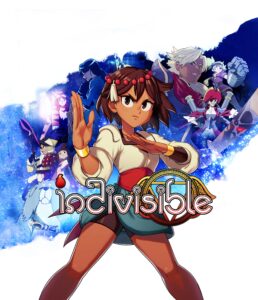On Oct. 8, 2019, “Indivisible” was released for PS4, Xbox One, Windows, Linux and macOS, with a Nintendo Switch release to be announced in the future.
“Indivisible” is the second game to be released by indie developer Lab Zero Games. The developer is known for their 2D fighting game “Skullgirls.”
Much like “Skullgirls,” “Indivisible” continues Lab Zero’s tradition of using hand-drawn animation and painted backgrounds.
“Indivisible” was initially announced as a crowdfunding project on Indiegogo on Oct. 5, 2015. The project had a goal of $1.5 million, launching alongside a playable prototype.
By the end of the campaign’s run on Dec. 5, the project had raised over $1.8 million.
Despite being an indie project, the game’s development saw collaborations with several well-known studios and artists.
Most notably, the game’s soundtrack was composed by “Secret of Mana” composer Hiroki Kikuta. The intro was animated by Studio Trigger and Titmouse, Inc. known for works such as “Kill la Kill” and “Motorcity,” respectively.

“Indivisible” centers on Ajna, voiced by Tania Gunadi. Ajna is a resident of a remote village in the jungle.
After her father is killed when the village is invaded and burned to the ground, Ajna decides to avenge his death.
This trauma awakens a hidden ability in Ajna—the ability to absorb people into her “Inner Realm” and call them out for assistance as companions known as Incarnations.
Unfortunately, the first Incarnation to fight alongside Ajna is Dhar, the man who murdered her father.
Ajna and Dhar reluctantly join forces to return to Lord Ravannavar, the man who ordered the attack. This throws Ajna into a grand adventure of self-discovery and forming new friendships.
The gameplay of “Indivisible” takes inspiration from the popular “MetroidVania” style of platforming, meshing it together with the semi-turn-based RPG combat of “Valkyrie Profile.”
Overworld exploration consists of platforming with a 2.5D perspective, meaning that the backgrounds are three-dimensional, but movement is on a two-dimensional plane.
This platforming sees Ajna dashing, wall jumping, and sliding through different environments, with platform difficulty varying from simple to highly complex.
Complex platforming areas often hide “Ringsels,” crystals that are used for attack and defense upgrades for battle.
Ajna can also learn special moves for traversing the environment when she gains a new item or encounters a new Incarnation.
The overworld is occupied by enemies that Ajna can attack, initializing battle.
Once battle commences, Ajna and her Incarnations populate the screen.
Because the game is semi-turn-based, there are no pauses during combat. Rather, Ajna and her Incarnations have an Action Point (AP) indicator below them that slowly fills up over time.
Actions are taken by pressing the respective face-button assigned to a character, such as Square, Triangle, Circle, or X.
Attacks can also be modified by holding up or down, with up often executing a high attack to hit airborne enemies.
The more AP a character has, the more consecutive moves they can make in a row.
This means that the pace combat can be determined by the players, who can have all four characters rush an enemy simultaneously or take it one character at a time.
However, the AP meter of enemies is not displayed for the player. An indicator appears on screen in the form of a line of sight, telegraphing which character the enemy is about to attack.
Players are then left to block in time, with precision timing resulting in an even lower amount of damage being taken from a normal block.
The player also has a group block which allows all characters to block at once, but consumes Iddhi. Iddhi can be saved up for special attacks.
When Iddhi is consumed, there are three levels of special attacks from Ajna and her Incarnations. The level of attack corresponds with how many bars of Iddhi are used.
Much of the charm of “Indivisible” comes from the world-building done in the game.
When traveling through cities, Ajna can talk with multiple non-playable characters (NPCs) for a brief exchange of dialogue.
Some critics often lambast these NPCs for standing out, as they were often designed by backers of the Indiegogo campaign. But the stand-out character designs feel right at home with the other characters who are directly involved in the story.
Many of the backer characters have unique designs that make them feel as if they are another adventurer in the midst of their own journey, simply crossing paths with Ajna for a quick moment.
Every character, regardless of story relevance, has been animated by hand.
Ajna and her Incarnations, along with any story-important characters, are all animated using hand-drawn techniques similar to that of cel animation.
Because of these hand-animated characters, each one feels unique and alive in their own way, often expressing aspects of their personalities through subtle movements.
These animations carry over into battle as well, with unique animations being given to each character’s special, normal and up/downward attacks.
Because of the animation’s fluidity, Lab Zero is able to create combo strings with seamless transition animations when a character uses their normal attacks. This technique was first designed for use in “Skullgirls.”
Characterization for Ajna, her Incarnations, and other key characters are expressed not only through the fluid animations but through the voice acting as well.
Characters such as Ajna, Kushi and Angwu have voice actors that provide accented performances for the characters.
Rather than simple English accent variants, characters often speak in non-native accents.
While “Skullgirls” was not dialogue-heavy, “Indivisible” takes the opposite approach by giving nearly every encountered character at least one piece of dialogue.
Dialogue is expressed in the traditional RPG and Visual Novel method of having character portraits with several expressions and poses superimposed on the overworld.
Lab Zero uses this opportunity to build and expand upon the world around the characters, allowing the player to become accustomed to the world at the same rate as Ajna.
The dialogue between characters is quick and snappy. It often incorporates subtle banter, adding interest without dragging out the conversations to an unnecessary length.
Despite the four years from announcement to release, it is clear that Lab Zero wanted to spend as much time and effort as possible in not cutting corners in the game’s development.
“Indivisible” is a game that features beautiful artistic presentation from start to finish, expressing the skills of Lab Zero staff in writing, animation and game design. It improves on everything that they were only able to give players a glimpse of before.

